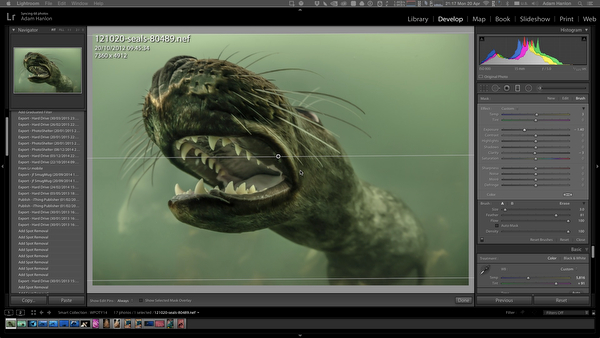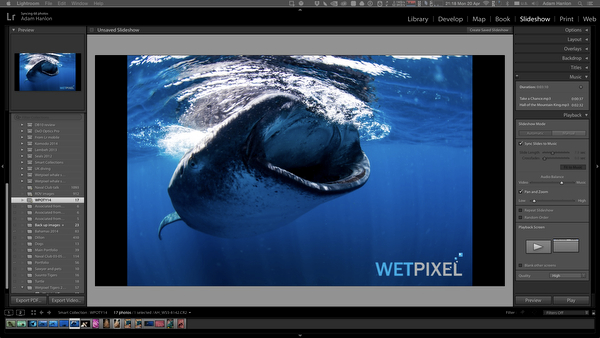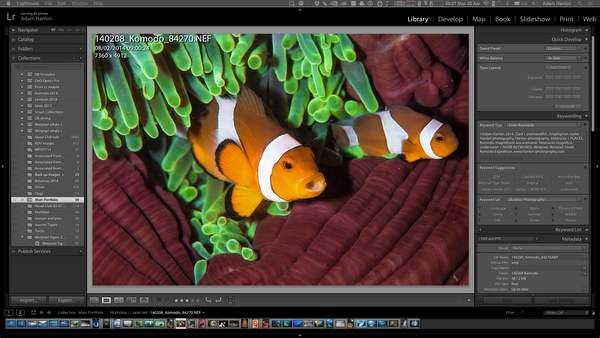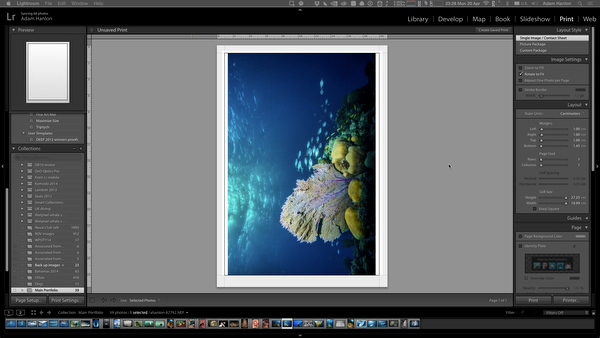Adobe Lightroom CC/6: Details and Review
Wetpixel Early Review: Lightroom CC/6

Performance
Lightroom CC benefits from using the computers GPU to render image changes and this has resulted in it feeling a lot more responsive.
Tonal changes occur almost instantly in the Develop mode and moving between panels also seems snappier. Import and preview generation do not seem a great deal faster, although the new automatic preview image sizing option will slow down their generation somewhat. Essentially this option, located in the Catalog Settings pane, means that Lightroom will automatically create previews sized appropriately for a display. If you are dealing with large displays (5K), then the images will take longer to render. My displays are 1920, and I felt that the import and rendering process took a similar amount of time to the previous version.

Importing and generating previews for a CF card containing 264 images and video at 11.1 GB via a USB 3 card reader took just under 14 minutes.
Import
The option of being able to import directly into a collection seems like a good addition. I haven’t figured out how I might use it yet, but feel that it could be of use for separating specific images. As is often the case, my workflow has developed without this option, so I cannot immediately think of a way to use it yet.
Keywording
The painter tool is a great option for adding keywords to large numbers of images that all have the same keywords, but share a folder with a few that do not need the keyword. An example might be a Tiger Beach trip, where many of the images may need to be keyworded with tiger shark: Galeocerdo cuvier, but there are probably a few shots of lemon and reef sharks that do not. Once the painter tool has been selected, (Cmd-opt-K or Ctrl-alt-K), holding down the shift key now brings up the last used keywords and the option of selecting a keyword set. This is much faster than selecting it via the Keyword List.
Develop module
The areas that Adobe has concentrated on here are the Photo Merge features, allowing HDR and panoramic images to be created in Lightroom. Whilst these may be useful in general, they have little application for most underwater photography.
Perhaps the single most useful new feature is the ability to use a brush to effectively create an image mask when using the gradient and radial filters. The gradient filter, in particular is very useful for adjusting exposure in the water column. With the brush, areas of the gradient filter can be removed, allowing for the filter to be applied over the whole images and then removed from the subject/foreground by using an erasing brush.
When using a mask to view the effects of the gradient, I found that there was significant lag when using the brush tool.
Another useful tip is that by holding the shift key and double clicking on the words “white” and “black” in the basic panel. Lightroom automatically sets the white and black points in an image, effectively increasing its dynamic range.

Slideshow module
The slideshow module has been overhauled and new functionality added. It can now be loaded with up to 10 tracks of music and the play order of these can be rearranged by dragging the songs around within the app. In addition, the slides can be synced to the music, and Lightroom will attempt to match the music’s tempo with slide changes. Alternatively, the slides can be “Fitted to the Music” in terms of duration, or assigned a fixed length for display and crossfade. Additionally, Lightroom now offers a pan and zoom effect, which adds movement to slideshows. Lastly, it offers a draft quality for arrangement, which can then be switch to standard or high quality for output.
What is still not easy to do in Lightroom is to add video to a slideshow, or to add text. Hence apps like fotomagico, Powerpoint or Keynote will probably still be the tools of choice for preparing presentations. I guess that Lightroom is a photography specific package and it is perhaps unrealistic to expect full slideshow presentation features within it.
Web module
Lightroom offer new HTML 5 templates for publishing onto a website. There are three templates provided, Classic, Square, Grid and Track. As in previous versions, the templates are customizable to some extent using the controls in the module. I liked the look of the Track Template, but rapidly went off it when I discovered that trying to add vertical (portrait) images caused it to hang!
So what is missing?
For me the major disappointment is the lack of any content aware tools within Lightroom CC/6. My most frequent round-trip to Photoshop is to use Content Aware Fill. It is a very photographer friendly tool, and it would be great to see it move into the photographer’s app.

Lightroom CC/6 is still using Process 2012 to render RAW images, and while I have no complaint about this, I can’t help but feel that improvements could have been made in the past 3 years. I think that this iteration is largely about moving the processing onto the GPU, and this development has occupied much of the developers’ time. I hope that the next iteration and updates to this version can now address improved functionality and new features.
Should I upgrade?
I do not know what Adobe’s plans are regarding camera support in legacy versions of Lightroom, but am aware that older versions of Lightroom have not been updated to allow the use of newer cameras. Hence the question is probably not Should I upgrade but When should I upgrade? Obviously, a new camera purchase now will inevitably mean that you will need to get an updated version.

I also think that the performance improvements in this version are worth the upgrade fee too, particularly if you work with large numbers of images. It is genuinely speedier that Lightroom 5.
When Adobe launched their Creative Cloud (CC), there were howls of protest. I have been using CC since it was launched and have yet to find it lacking in any way. Even when there have been long periods when I have not been able to get an internet connection, it has continued to work. In my opinion, the Creative Cloud Photography Plan at $9.99/month for Lightroom and Photoshop CC represents better value than buying Lightroom and “making do” with the reduced functionality of CS6.